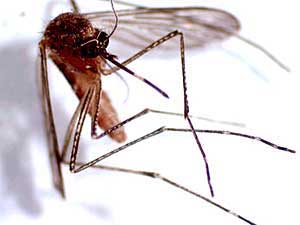|
Audio
Photos
More from MPR
Resources
|
August 29, 2005
Officials announce new cases of West Nile virus nearly every day, and the next two weeks are considered the peak season for the mosquito-borne illness. So far more than 100 residents of South Dakota have the disease, as well as about a dozen in Minnesota. Lyme disease also reaches its peak this time of year. Eastern Minnesota is one of the highest risk areas for the tick-borne disease. The statistics from state officials tell only the numbers. But the diseases are real, and sometimes frustrating for the people who get them and the doctors who treat them.
Sioux Falls, S.D. — Audree Hanson, 51, is still recovering from West Nile virus. Hanson was diagnosed two years ago but it's an illness she'll never forget. It started out with an aching leg that lasted about three days.
"Then by the fourth day I started feeling real achy all over, and that was on a Thursday," recalls Hanson. "Then Friday it just hit me like a wall -- severe aching. My leg ached so bad I couldn't hardly walk. Super-tired, nauseated, the whole thing. All I wanted to do was sleep. So I thought I had a bad flu."
On that Saturday, Hanson went to the hospital. Hospital staff did no tests and told her to go home. If her symptoms got worse, Hanson was told to see her family doctor on Monday. She did, and that's when she was tested for West Nile virus. The final positive diagnosis didn't come until Hanson was already back at work, two weeks later.
There's no treatment for West Nile. Hanson says she just had to suffer through it. She says she can still feel the after-effects, because one leg is weaker than the other.
"It's like when you get dressed and you pull up one leg and then the other, how you're standing on one leg, and it's kind of like, whoops," says Hanson. "Standing on your tiptoes -- it's just a real subtle thing, you can feel it's different but it isn't like stopping me. I'm not tripping or falling, it's just weaker. I know it's weaker, it's just different."
The after-effects of West Nile virus can be permanent. Dr. Wendell Hoffman, infectious disease specialist at Sioux Valley Hospital in Sioux Falls, says West Nile hits everyone differently.
"The basic teaching is only about 20 percent of people who come into contact with the virus that causes West Nile will actually get symptoms. So that means 80 percent will develop an immune response but they will not get sick," says Hoffman.
Hoffman says that's still a lot of people who could get sick. He says people need to take responsibility to protect themselves from insect bites.
To avoid being bitten by mosquitoes, people should wear long sleeves, use repellent with DEET, and avoid being outside at the prime mosquito feeding times -- at dawn or dusk.
West Nile victim Audree Hanson says she doesn't remember being bitten by a mosquito before she got sick. She says she knows she didn't wear repellant, because she never does.
"Mosquitoes don't usually like me," says Hanson. "I'm the kind of person who can be outside (and) I never use bug spray because they don't bother me. They love my husband. We could be sitting right next to each other and they just flock to him, and just one or two will come around me. But I don't remember being bit at all."
It's not clear whether everyone who contracts the West Nile virus develops an immunity. Audree Hanson believes she's safe from ever getting the virus again, but she says physicians still have a lot to learn about it.
Dr. Wendell Hoffman agrees that they are still on a learning curve. He says there are numerous viruses and bacteria diseases transmitted by insects.
The most common illness from ticks is Lyme disease. Hoffman says the best way to protect yourself from Lyme disease is to inspect your body for ticks and remove them before being bitten. He says it's also important to know if you're in a high-risk area.
Unlike West Nile virus, Lyme disease can be treated with antibiotics because it's a bacterial infection.
Lyme disease is usually diagnosed by a bullseye-shaped rash around the bite. Hoffman says physicians are well-trained to spot Lyme disease as well as West Nile virus. But often a patient's symptoms are similar to many other diseases.
"They'll come in with fever and headache. How often does that occur with other types of infections, and that's the challenge," says Hoffman.
Hoffman says if someone comes into a doctor's office in in August or September, that's a signal for doctors to test for mosquito and tick-borne diseases.







